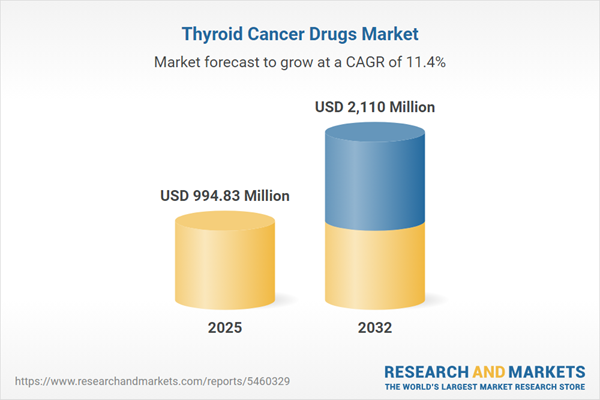Speak directly to the analyst to clarify any post sales queries you may have.
Senior decision-makers in the thyroid cancer drugs market face a continually evolving environment, driven by clinical advances, shifting regulatory landscapes, and ongoing innovation in patient care solutions.
Thyroid Cancer Drugs Market Snapshot
The thyroid cancer drugs market is experiencing significant change, with a global value estimated at USD 890.96 million in 2024 and anticipated to reach USD 994.83 million by 2025, reflecting an 11.40% compound annual growth rate. Current trends highlight increased adoption of molecular diagnostics, rising investment in personalized oncology therapies, and rapid adaptation to evolving compliance requirements. Pharmaceutical manufacturers are diversifying their portfolios to expand therapeutic reach and respond to both international and local regulations. Sustained market presence now depends on agile business strategies that address unpredictable disease dynamics, facilitate access to next-generation therapies, and adapt to new healthcare delivery models.
Scope & Segmentation of the Thyroid Cancer Drugs Market
This report provides detailed segmentation to equip senior leaders with strategic clarity, enabling focused resourcing and effective risk management. The segmentation framework targets critical domains where leadership decisions shape market participation and future outcomes:
- Cancer Types: Papillary, follicular, Hürthle cell, medullary, and anaplastic cancer types. Distinctive therapy development and individualized clinical strategies are required within each category, supporting competitive product differentiation and guiding research directions.
- Treatment Modalities: Chemotherapy, immunotherapy, radioiodine therapy, surgery, thyroid stimulating hormone suppression, and targeted multikinase therapies. Diverse modalities support patient-centric management and expand options for clinical service delivery.
- Drug Types: Immunotherapies, hormone-based drugs, targeted treatments, and chemotherapeutics. Each drug type offers adaptability in protocol design, ensuring response to clinical advances and evolving care standards.
- Mode of Administration: Tablets, capsules, injectables, and pre-filled syringes. Multiple administration methods facilitate flexibility for healthcare systems and accommodate patient preferences, improving adherence and outcomes.
- End Users: Hospitals, homecare providers, oncology clinics, and research organizations. Each end user segment influences buying behavior and integration within varied healthcare infrastructures, impacting access and utilization.
- Geographies: Americas, Europe, Middle East, Africa, and Asia-Pacific. Key markets such as the United States, Germany, Japan, China, and Brazil drive demand patterns, each introducing distinct investment flows and market characteristics.
- Key Players: Eisai Co., Ltd., Exelixis, Inc., Bayer AG, AstraZeneca PLC, Blueprint Medicines Corporation, Eli Lilly and Company, Merck & Co., Inc., Merck KGaA, Novartis AG, and Pfizer Inc. These leading companies set sector trends and drive the competitive landscape.
Emerging technologies, including molecular profiling, companion diagnostics, and artificial intelligence, continue to enhance precision in patient selection, accelerate treatment planning, and support refined segmentation efforts. Leaders must remain alert to global regulatory changes and the growing integration between diagnostics, therapies, and data-driven solutions to maintain sustained advantage.
Key Takeaways for Senior Decision-Makers
- Precision oncology is central to product pipeline innovation and drives the need for novel technology incorporation across the thyroid cancer drugs market.
- Growth in immuno-oncology and targeted options is influencing both clinical standards and the adoption of more tailored, value-based care models.
- Artificial intelligence is delivering actionable insights, enabling more efficient clinical and operational decision-making processes.
- Strategic segmentation by cancer subtype, treatment approach, and market geography enhances supplier partnerships and aligns operations with a shifting regulatory environment.
- Collaboration among manufacturers, diagnostics entities, advocacy groups, and distributors accelerates therapy access and fosters a robust innovation cycle.
- Industry moves such as mergers, acquisitions, and portfolio expansion shape competitive positioning in an increasingly dynamic oncology sector.
Tariff Impact and Supply Chain Strategy
Upcoming United States tariff adjustments in 2025 are expected to affect both production costs and pricing structures within the thyroid cancer drugs market. Senior leaders should cultivate resilient supplier networks, diversify sourcing strategies, and vigilantly track policy shifts to mitigate market uncertainty. Collaborative supply chain management and forward planning promote pricing stability and ensure dependable delivery, particularly in regions where patient access is a top priority.
Methodology & Data Sources
This analysis is based on multidisciplinary research, integrating perspectives from oncology clinicians, pharmaceutical executives, and regulatory professionals. Findings reflect peer-reviewed scholarship, proprietary market datasets, and expert regulatory guidance to provide senior decision-makers with robust evidence for strategic action.
Why This Report Matters
- Enables smarter procurement, pricing, and compliance decisions to strengthen market access and operational agility.
- Offers in-depth insight into trends in diagnostics and therapies, supporting effective portfolio management and informed market entry strategies.
- Prepares leaders to navigate changes in reimbursement and patient access policies across geographically diverse healthcare systems.
Conclusion
Continued adaptability, a focus on innovation, and development of key partnerships are essential for maintaining success in the thyroid cancer drugs market. Thoughtful leadership is vital in ensuring resilience and organizational longevity as the sector evolves.
Additional Product Information:
- Purchase of this report includes 1 year online access with quarterly updates.
- This report can be updated on request. Please contact our Customer Experience team using the Ask a Question widget on our website.
Table of Contents
3. Executive Summary
4. Market Overview
7. Cumulative Impact of Artificial Intelligence 2025
List of Figures
Companies Mentioned
The companies profiled in this Thyroid Cancer Drugs market report include:- Eisai Co., Ltd.
- Exelixis, Inc.
- Bayer AG
- AstraZeneca PLC
- Blueprint Medicines Corporation
- Eli Lilly and Company
- Merck & Co., Inc.
- Merck KGaA
- Novartis AG
- Pfizer Inc.
Table Information
| Report Attribute | Details |
|---|---|
| No. of Pages | 195 |
| Published | November 2025 |
| Forecast Period | 2025 - 2032 |
| Estimated Market Value ( USD | $ 994.83 Million |
| Forecasted Market Value ( USD | $ 2110 Million |
| Compound Annual Growth Rate | 11.4% |
| Regions Covered | Global |
| No. of Companies Mentioned | 11 |









